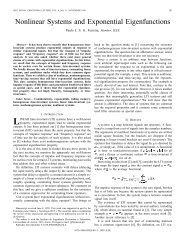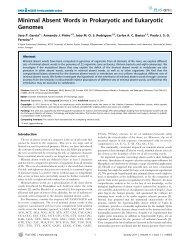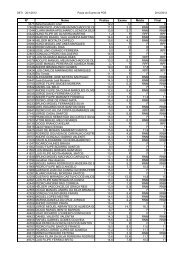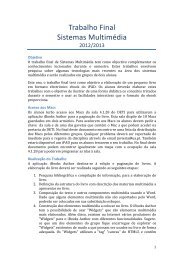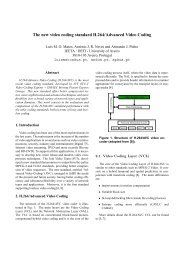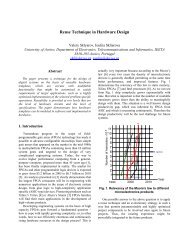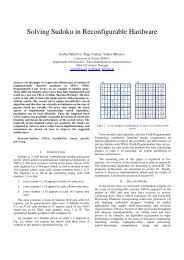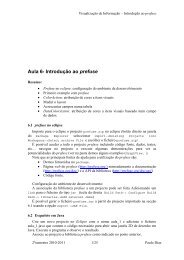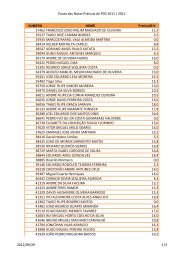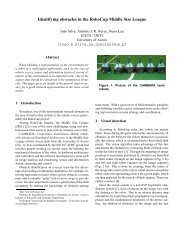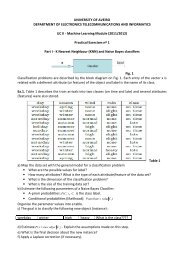Optimization of Recursive Sorting Algorithms for ... - ResearchGate
Optimization of Recursive Sorting Algorithms for ... - ResearchGate
Optimization of Recursive Sorting Algorithms for ... - ResearchGate
Create successful ePaper yourself
Turn your PDF publications into a flip-book with our unique Google optimized e-Paper software.
22nd International Conference on Microelectronics (ICM 2010)<br />
<strong>Optimization</strong> <strong>of</strong> <strong>Recursive</strong> <strong>Sorting</strong> <strong>Algorithms</strong> <strong>for</strong><br />
Implementation in Hardware<br />
Dmitri Mihhailov<br />
Computer Department,<br />
TUT,<br />
Tallinn, Estonia<br />
d.mihhailov@ttu.ee<br />
Valery Sklyarov<br />
DETI/IEETA,<br />
University <strong>of</strong> Aveiro,<br />
Aveiro, Portugal<br />
skl@ua.pt<br />
Iouliia Skliarova<br />
DETI/IEETA,<br />
University <strong>of</strong> Aveiro,<br />
Aveiro, Portugal<br />
iouliia@ua.pt<br />
Alexander Sudnitson<br />
Computer Department,<br />
TUT,<br />
Tallinn, Estonia<br />
alsu@cc.ttu.ee<br />
Abstract—The paper describes the hardware implementation and<br />
optimization <strong>of</strong> recursive algorithms that sort data using binary<br />
trees. Since recursive calls are not directly supported by hardware<br />
description languages, they are implemented using the known<br />
model <strong>of</strong> a hierarchical finite state machine (HFSM). The paper<br />
suggests new hardware-oriented recursive algorithms, describes<br />
their implementation in hardware; reports the results <strong>of</strong> numerous<br />
experiments; provides analysis and comparison <strong>of</strong> alternative and<br />
competitive techniques. The results clearly demonstrate that<br />
per<strong>for</strong>mance <strong>of</strong> sorting operations is increased comparing to other<br />
known implementations.<br />
Index Terms—Circuit synthesis, Field programmable gate<br />
arrays, Finite state machines, <strong>Sorting</strong>; Tree data structures<br />
R<br />
I. INTRODUCTION<br />
ecursion is a powerful problem-solving technique [1] that<br />
may be applied to problems that can be decomposed into<br />
smaller sub-problems that are <strong>of</strong> exactly the same <strong>for</strong>m as<br />
the original. Many examples that demonstrate the advantages <strong>of</strong><br />
recursion are presented in [1-12]. An in-depth review and<br />
comparison <strong>of</strong> different approaches to hardware implementation<br />
[3-10] appears in [13]. The advantages and disadvantages <strong>of</strong><br />
recursive techniques in s<strong>of</strong>tware are well known [1]. It has been<br />
shown however [5] that recursion can be implemented in<br />
hardware more efficiently than in s<strong>of</strong>tware.<br />
<strong>Recursive</strong> algorithms are frequently used in a wide range <strong>of</strong><br />
practical applications [1]. They are employed most <strong>of</strong>ten <strong>for</strong><br />
various kinds <strong>of</strong> binary search [1, 5]. Let us consider an example<br />
<strong>of</strong> using a binary tree <strong>for</strong> sorting data [1]. Suppose that the nodes<br />
<strong>of</strong> the tree contain three fields: a pointer to the left child node, a<br />
pointer to the right child node, and a value (e.g. an integer or a<br />
pointer to a string). The nodes are maintained so that at any node,<br />
the left sub-tree only contains values that are less than the value<br />
at the node, and the right sub-tree contains only values that are<br />
greater. Such a tree can easily be built and traversed recursively.<br />
<strong>Sorting</strong> <strong>of</strong> this type will be considered in the paper as a case<br />
study to demonstrate the proposed new techniques and their<br />
advantages. A brief summary <strong>of</strong> what is new and distinctive in<br />
this paper is given below:<br />
• The analysis and comparison <strong>of</strong> alternative and competing<br />
techniques <strong>for</strong> describing hierarchical algorithms. The basis<br />
<strong>for</strong> the comparison is the results obtained <strong>for</strong> recursive<br />
sorting algorithms in [5-7] that have already been compared<br />
in [5-7] with other known techniques. This paper suggests<br />
several improvements in the description <strong>of</strong> such algorithms<br />
and demonstrates advantages confirmed by FPGA-based<br />
implementations and experiments.<br />
• New hardware architectures based on the use <strong>of</strong> dual-port<br />
memories.<br />
• Parallel implementations.<br />
The remainder <strong>of</strong> this paper is organized in four sections.<br />
Section II is dedicated to recursive data sorting with the emphasis<br />
on the innovations proposed. Section III reports the results <strong>of</strong><br />
experiments. Section IV presents comparisons and analysis <strong>of</strong> the<br />
models, methods and implementations in hardware and s<strong>of</strong>tware.<br />
The conclusion is given in Section V.<br />
II.<br />
RECURSIVE DATA SORTING<br />
A. A Known Technique<br />
<strong>Algorithms</strong> <strong>for</strong> many computational problems are based on<br />
the generation and traversal <strong>of</strong> a binary tree where the recursive<br />
technique is very helpful. Indeed, during the search <strong>for</strong> the proper<br />
place <strong>for</strong> a new data item we can: 1) compare the new data item<br />
with the value <strong>of</strong> the root node to determine whether it should be<br />
placed in the sub-tree headed by the left node or the right node;<br />
2) check <strong>for</strong> the presence <strong>of</strong> the node selected by 1) and if it is<br />
absent, create and insert a new node <strong>for</strong> the data item and end the<br />
process; 3) repeat 1) and 2) with the selected node as the root.<br />
Recursion can easily be applied in point 3. Let us assume<br />
that a tree <strong>for</strong> sorting has already been built. Now we would like<br />
to use the tree to output the sorted data. Fig. 1 demonstrates the<br />
known technique [5] where there are 10 incoming data items in<br />
the sequence shown (a) that are extracted from the tree in<br />
accordance with the algorithm (b). The data items are stored in<br />
RAM along with the addresses <strong>of</strong> the left (LA) and right (RA)<br />
sub-trees (c). All other details can be found in [5,6]. Let us call<br />
this known method S1.<br />
It is known [14] that recursive algorithms can be specified by<br />
hierarchical graph-schemes (HGS). A HGS can easily be<br />
converted to a hierarchical finite state machine (HFSM) and then<br />
<strong>for</strong>mally described in a hardware description language (HDL)<br />
using the HDL templates proposed in [5]. The resulting<br />
978-1-61284-150-2/10/$26.00 ©2010 IEEE 471
(customized) HDL code is synthesizable and permits the<br />
hardware to be designed. Two different HFSM models with<br />
explicit and implicit modules are known and all necessary details<br />
can be found in [15].<br />
a)<br />
7<br />
11<br />
17<br />
19<br />
20<br />
22<br />
15 21<br />
31<br />
35<br />
Sequence 1) 2) 3) 4) 5) 6) 7) 8) 9) 10)<br />
<strong>of</strong> input: 19, 22, 17, 20, 35, 11, 21, 31, 15, 7<br />
Output: 7, 11, 15, 17, 19, 20, 21, 22, 31, 35<br />
b)<br />
no<br />
z<br />
Begin<br />
Left sub-tree<br />
exists<br />
yes<br />
Call z again <strong>for</strong><br />
left node as a root<br />
Output data from<br />
the last node<br />
Right sub-tree<br />
exists<br />
yes<br />
Call z again <strong>for</strong><br />
right node as a root<br />
c)<br />
End<br />
no<br />
RAM<br />
Data LA RA<br />
Fig. 1. Binary tree <strong>for</strong> data sort (a); recursive algorithm <strong>for</strong> data sort (b); contents<br />
<strong>of</strong> memory (c)<br />
B. Innovation<br />
It is shown below that the known algorithm [5] can be<br />
improved (can be made faster) in hardware through the use <strong>of</strong><br />
dual-port memories, algorithmic modifications and simultaneous<br />
traversal <strong>of</strong> the left and right sub-trees.<br />
The main difference in the first new method (let us call it S2)<br />
is that it uses dual-port memories (described below) and a buffer<br />
register to store the currently selected node in the <strong>for</strong>mat:<br />
data+LA+RA. Fig. 2 gives the necessary details.<br />
The dual-port memory permits two words to be accessed<br />
simultaneously through LA and RA <strong>of</strong> the buffer register. Each<br />
word stores similar in<strong>for</strong>mation to the buffer register (i.e.<br />
data+LA+RA) <strong>for</strong> the left and <strong>for</strong> the right nodes. There are two<br />
basic fragments in the proposed algorithm z 1 (µ) (see Fig. 2b) that<br />
are shown in gray at the top and bottom. Initially, the buffer<br />
register holds the root <strong>of</strong> the sorting tree. The top module<br />
z 1 (µ=left) examines left sub-trees. If a left sub-tree (node) exists<br />
then it is checked again, i.e. to determine whether the left subtree<br />
also has either left or right sub-trees (nodes). If there is no<br />
sub-tree from the left node, then the value <strong>of</strong> the node is the<br />
leftmost data value and can be output as the smallest. In the last<br />
case the node in the buffer register holds the second smallest<br />
value and the relevant data value is sent to the output. The bottom<br />
module z 1 (µ=right) per<strong>for</strong>ms similar operations <strong>for</strong> right nodes.<br />
Let us consider the example in Fig. 2c, where addresses are<br />
designated by letters a,b,…,j. Initially, the buffer register<br />
contains the data <strong>for</strong> the root node. There is a left node b from a<br />
and a left node from b. Thus, z is called again recursively and the<br />
buffer register stores the data <strong>for</strong> b. Then z is called recursively<br />
once again and the buffer register stores the data <strong>for</strong> d. There is a<br />
left node g from d but there are no child nodes from g (neither<br />
left nor right). Thus, the value 7 <strong>of</strong> g is chosen as the smallest, the<br />
value 11 from d is selected as the second smallest and z 1 (µ=right)<br />
at the bottom is started. There is the right node h from d but there<br />
are no child nodes from h. Thus, the value 15 <strong>of</strong> h is considered<br />
to be the next smallest and: a return from the recursively called<br />
module z is per<strong>for</strong>med; the buffer register receives the data <strong>for</strong> b;<br />
and the value 17 from b is sent to the output as the next smallest.<br />
The module z 1 (µ=right) does not detect any right sub-tree from b<br />
and, thus a new return from the recursively called module is<br />
executed; and the buffer register receives data <strong>for</strong> a. Now the<br />
value 19 from a is considered to be the next smallest. After that a<br />
similar sequence <strong>of</strong> operations will be executed <strong>for</strong> the right subtree<br />
<strong>of</strong> a, i.e. <strong>for</strong> the sub-tree with the root c.<br />
a)<br />
Fragment<br />
<strong>of</strong> a tree<br />
<strong>for</strong> left<br />
Buffer register<br />
Data LA RA<br />
<strong>for</strong> left<br />
Data LA RA Data LA RA<br />
Port A Port B<br />
Data LA RA Data LA RA<br />
dual-port RAM<br />
c)<br />
Buffer register<br />
a<br />
19 19 b c<br />
RAM: Port A<br />
17 d no<br />
RAM: Port B<br />
22 e f<br />
RAM: Port A b 17 22 c<br />
11 g h<br />
d<br />
11 e<br />
RAM: Port A 20 f 35<br />
7 no no<br />
g 7 h 15 i 21 31 j<br />
b)<br />
z 1 (µ)<br />
z 1 (µ)<br />
z<br />
Begin<br />
µ sub-tree<br />
exists<br />
yes<br />
sub-tree<br />
exists <strong>for</strong> µ<br />
node<br />
no<br />
Output data from<br />
µ node<br />
Call z again <strong>for</strong><br />
µ node as a root<br />
End<br />
Replace µ with “right”<br />
<strong>for</strong> this fragment<br />
Replace µ with “left” <strong>for</strong> this fragment<br />
no<br />
yes<br />
no<br />
yes<br />
Call z again <strong>for</strong><br />
µ node as a root<br />
Output data from<br />
the last root<br />
µ sub-tree<br />
exists<br />
yes<br />
sub-tree<br />
exists <strong>for</strong> µ<br />
node<br />
no<br />
Output data from<br />
µ node<br />
Fig. 2. The first improvement (S2): the use <strong>of</strong> dual-port memory (a); algorithm<br />
(b); example (c)<br />
If you look at Fig. 2b you can see that the module z 1 (µ) at the<br />
top is exactly the same as the module z 1 (µ) at the bottom. Indeed,<br />
just the argument µ is different: in the first case µ=left and in the<br />
second case µ=right. Thus, we can benefit again from the<br />
hierarchy supported by a HFSM model and use the same module<br />
z 1 (µ) (and, consequently, the same circuit) with different input<br />
data that can be properly chosen by a multiplexer.<br />
The main difference in the second new method (let us call it<br />
S3) is the checking <strong>of</strong> LA and RA <strong>for</strong> each word in the dual-port<br />
RAM independently. The top-level algorithms is the same as in<br />
Fig. 2b (see Fig. 3a), but the module z 1 (µ) is different (see Fig.<br />
3b).<br />
Let us consider the same example shown in Fig. 2c. Suppose,<br />
the left sub-tree <strong>of</strong> the tree in Fig. 2c has already been traversed<br />
and we got the sorted sequence: 7, 11, 15, 17, 19. The last value<br />
(19) is taken in the middle rectangle <strong>of</strong> Fig. 3a. So, z 1 (µ=right)<br />
has to be called next. Since a right sub-tree (beginning with the<br />
node c) <strong>of</strong> the node a exists and it (i.e. c) has the left node e, the<br />
module z will be called again <strong>for</strong> the node c. The module<br />
z 1 (µ=left) detects the left node e, which does not have any left<br />
node. Thus, the value 20 is selected. Since the node e has the<br />
right node i, the module z is called again <strong>for</strong> the node i. Note that<br />
the module z is not called <strong>for</strong> the node e and the control jumps<br />
directly from the node c to the node i. This is the main difference<br />
with S2. The node i does not have a left sub-tree (which is why<br />
472
the value 21 is chosen), or a right sub-tree (which is why the<br />
return from the recursive module is per<strong>for</strong>med). The node c<br />
becomes the current active node and the value 22 is selected.<br />
Then the module z 1 (µ=right) is executed. The node c has the right<br />
node f and f has the left node j. Thus, the value 31 is selected.<br />
The node f does not have a right sub-tree and the value 35 is the<br />
last value in the sorting sequence. After that there is one more<br />
return from the recursive module and the algorithm is terminated.<br />
a)<br />
z Begin<br />
b) Begin z 1 (µ)<br />
z 1 (µ=left)<br />
Output data from<br />
the last node<br />
z 1 (µ=right)<br />
End<br />
yes<br />
Call z again <strong>for</strong><br />
right node as a root<br />
Output data from<br />
µ node<br />
right sub-tree<br />
exists <strong>for</strong> µ<br />
node<br />
no<br />
no<br />
µ sub-tree<br />
exists<br />
yes<br />
left sub-tree<br />
exists <strong>for</strong> µ<br />
node<br />
yes<br />
Call z again <strong>for</strong><br />
µ node as a root<br />
End<br />
Fig. 3. The second algorithm: top-level module z (a); module z1(µ) (b)<br />
In the last method that we propose (let us call it S4), the left<br />
(such as the sub-tree with the root b in Fig. 3c) and right (such as<br />
the sub-tree with the root c in Fig. 3c) sub-trees <strong>of</strong> the tree are<br />
traversed in parallel using the method S1. There are two<br />
simultaneously functioning HFSMs that are a master and a slave.<br />
The master HFSM builds the tree, outputs the left sub-tree, and<br />
activates the slave HFSM when necessary. The slave HFSM<br />
outputs the right sub-tree. Processing <strong>of</strong> both sub-trees can be<br />
done simultaneously. The main objective <strong>of</strong> the method S4 is to<br />
evaluate the potential benefits <strong>of</strong> parallelism. Obviously, more<br />
parallel branches can be introduced using cascade structures.<br />
III.<br />
FPGA-BASED IMPLEMENTATIONS AND EXPERIMENTS<br />
A. Experiments<br />
The synthesis and implementation <strong>of</strong> the circuits from the<br />
specification in VHDL were done in Xilinx ISE 11 <strong>for</strong> FPGA<br />
Spartan3E-1200E-FG320 <strong>of</strong> Xilinx. A random-number generator<br />
produces 2 11 items <strong>of</strong> data with a length <strong>of</strong> 14 bits (i.e. values in<br />
an interval between 0 and 16383). Values greater than 9999 are<br />
removed leaving 1200-1300 items available <strong>for</strong> further<br />
processing. These items are sorted using the following FPGAbased<br />
implementations:<br />
no<br />
1. Four algorithms described in section II: S1 (the known<br />
algorithm) and S2, S3, and S4 (the three algorithms<br />
proposed in this paper). For all algorithms S1,…,S4 the<br />
HFSM with explicit modules [15] was used. The results are<br />
presented in Table I. The columns SN (N∈{1,2,3,4})<br />
indicate the number <strong>of</strong> clock cycles <strong>for</strong> sorting by the<br />
algorithm SN; the Data column indicates the number <strong>of</strong> data<br />
items that were sorted; the l/r column indicates Number <strong>of</strong><br />
nodes <strong>of</strong> left sub-tree from the root/Number <strong>of</strong> nodes <strong>of</strong><br />
right sub-tree from the root.<br />
2. For two algorithms described in section II S1 and S3 the<br />
HFSM with implicit modules [15] was used. Let us call the<br />
relevant implementations S1n and S3n. The number <strong>of</strong> clock<br />
cycles is the same as <strong>for</strong> the columns S1 and S3 in Table I.<br />
Besides, the algorithm S1 was described in C++ and<br />
implemented in s<strong>of</strong>tware. Other algorithms (S2, S3, S4) are<br />
hardware-oriented and their advantages have appeared just in<br />
hardware. The same data (randomly generated) were used <strong>for</strong> the<br />
s<strong>of</strong>tware implementations. The results were produced on HP<br />
EliteBook 2730p (Intel Core 2 Duo CPU, 1.87 GHz) computer.<br />
TABLE I.<br />
THE RESULTS OF EXPERIMENTS<br />
Data l/r S1 S2 S3 S4<br />
1286 1/1284 5143 3841 3589 6424<br />
1278 53/1224 5111 3854 3584 6124<br />
1248 143/1104 4991 3779 3467 5524<br />
1211 185/1025 4843 3637 3373 5129<br />
1216 266/949 4863 3687 3393 4749<br />
1248 322/915 4991 3743 3486 4579<br />
1203 460/742 4811 3608 3350 3714<br />
1228 528/699 4911 3705 3432 3499<br />
1212 556/655 4847 3639 3350 3279<br />
1230 623/606 4919 3722 3470 3101<br />
1305 742/562 5919 3896 3596 3533<br />
1259 822/436 5035 3796 3496 3727<br />
1230 799/430 4919 3665 3419 3629<br />
1304 849/454 5215 3925 3610 3853<br />
1276 963/312 5103 3813 3564 4167<br />
1225 958/256 4899 3699 3417 4101<br />
1225 986/238 4899 3705 3420 4185<br />
1199 1051/147 4795 3586 3319 4354<br />
1309 1288/20 5235 3927 3639 5175<br />
1204 1203/0 4815 3603 3387 4816<br />
IV.<br />
ANALYSIS OF THE RESULTS AND COMPARISONS<br />
A. Per<strong>for</strong>mance<br />
The algorithm S3 gives the best results as a rule (see Table I).<br />
Nevertheless, the results <strong>of</strong> S4 are better <strong>for</strong> well balanced trees.<br />
We believe that additional research ef<strong>for</strong>ts are needed to explore<br />
the potential <strong>for</strong> parallel sorting and the results look promising.<br />
The experiments have shown that the hardware<br />
implementations are faster in about 4.5 times than s<strong>of</strong>tware<br />
implementations <strong>for</strong> all the experiments even though the clock<br />
frequencies <strong>of</strong> the FPGA and the PC differ significantly.<br />
473
B. Resource Consumption<br />
Fig. 4 shows the resource (Slices, CLBs, BRAMs)<br />
consumption and maximum clock frequency <strong>for</strong> different<br />
implementations, where:<br />
• b indicates that the stacks <strong>for</strong> HFSMs are built from Block<br />
RAM. For all implementations not marked with b the stacks<br />
are built from LUTs;<br />
• n designates the HFSM with implicit modules;<br />
• codec indicates that decoding (to minimize the size <strong>of</strong> the<br />
stack) has been used (see [15] <strong>for</strong> details);<br />
• m denotes an additional level <strong>of</strong> modularity, as in Fig. 3.<br />
As can be seen, the circuits in which the stacks are built from<br />
block RAMs consume the least number <strong>of</strong> slices and CLBs and<br />
they require 1 or 2 additional block RAMs. However, the<br />
maximum clock frequency <strong>for</strong> such circuits is lower than <strong>for</strong><br />
similar implementations with the stacks built from CLBs.<br />
Number<br />
Frequency in MHz<br />
Number <strong>of</strong> BRAMx10<br />
Implementations<br />
Implementations<br />
Fig. 4. Resources needed and maximum clock frequency <strong>for</strong> different<br />
implementations<br />
Note that the chosen FPGA is very cheap and not very fast.<br />
The use <strong>of</strong> significantly more advanced and faster FPGAs<br />
available on the market (e.g. Virtex-5/6 families) would permit<br />
even faster recursive sorting circuits to be implemented.<br />
An analysis <strong>of</strong> Table I and Fig. 4 permits the following<br />
conclusions to be drawn: 1) the algorithm S3 provides, as a rule,<br />
the best per<strong>for</strong>mance; 2) the implementation S1nb_codec requires<br />
the smallest hardware resources; 3) the implementations S2m and<br />
S3m better support modularity and reusability and <strong>of</strong>fer potential<br />
<strong>for</strong> refinement; 4) we found that the developed hardware is easily<br />
scalable and can be used <strong>for</strong> any number <strong>of</strong> data items bounded<br />
just by FPGA resources.<br />
V. CONCLUSION<br />
The paper suggests new hardware-oriented algorithms <strong>for</strong><br />
solving sorting problems over tree-based structures, and clearly<br />
demonstrates the advantages <strong>of</strong> the innovations proposed based<br />
on FPGA prototyping and abundant experiments.<br />
Recommendations and discussions are also presented.<br />
Obviously, the results <strong>of</strong> the paper are not limited to just<br />
recursive sorting. They have a wide scope and can be applied<br />
effectively to systems that implement algorithms over tree-like<br />
structures.<br />
ACKNOWLEDGMENT<br />
This research was supported by the European Union through<br />
the European Regional Development Fund and by the Estonian<br />
Doctoral School in In<strong>for</strong>mation and Communication Technology.<br />
REFERENCES<br />
[1] T.H. Cormen, C.E. Leiserson, R.L. Rivest, C. Stain, Introduction to<br />
<strong>Algorithms</strong>, 2nd edition, MIT Press, 2002.<br />
[2] J.V. Nobble, “Recurses!”, Computing in Science & Engineering, May/June<br />
2003, vol. 5, issue 3, pp. 76-81.<br />
[3] T. Maruyama, M. Takagi, T. Hoshino, “Hardware implementation<br />
techniques <strong>for</strong> recursive calls and loops”, Proc. 9th Int. Workshop FPL’99,<br />
Glasgow, UK, 1999, pp. 450-455.<br />
[4] T. Maruyama, T. Hoshino, “A C to HDL compiler <strong>for</strong> pipeline processing<br />
on FPGAs”, Proc. IEEE Symp. on Field-Programmable Custom Comp.<br />
Machines - FCCM’2000, CA, USA, 2000, pp. 101-110.<br />
[5] V. Sklyarov, “FPGA-based implementation <strong>of</strong> recursive algorithms,”<br />
Microprocessors and Microsystems. Special Issue on FPGAs: Applications<br />
and Designs, vol. 28/5-6, pp. 197–211, 2004.<br />
[6] V. Sklyarov, I. Skliarova, B. Pimentel, "FPGA-based Implementation and<br />
Comparison <strong>of</strong> <strong>Recursive</strong> and Iterative <strong>Algorithms</strong>", Proc. 15th Int.<br />
FPL'2005, Finland, 2005, pp. 235-240.<br />
[7] I. Skliarova, V. Sklyarov, "<strong>Recursive</strong> versus Iterative <strong>Algorithms</strong> <strong>for</strong><br />
Solving Combinatorial Search Problems in Hardware", Proc. 21st Int.<br />
Conference on VLSI Design, Hyderabad, India, 2008, pp. 255-260.<br />
[8] G. Ferizis, H. ElGindy, “Mapping recursive functions to reconfigurable<br />
hardware”, Proc. 16th Int. Conference FPL’06, Madrid, Spain, 2006, pp.<br />
283-288.<br />
[9] S. Ninos, A. Dollas, “Modeling recursion data structures <strong>for</strong> FPGA-based<br />
implementation”, Proc.18th Int. Conference FPL’08, Heidelberg, Germany,<br />
2008, pp. 11-16.<br />
[10] G. Stitt, J. Villarreal, “Recursion flattering”, Proc. 18th ACM Great Lakes<br />
symp. on VLSI – GLSVLSI’08, FL, USA, 2008, pp. 131-134.<br />
[11] S.A. Edwards, “The Challenges <strong>of</strong> Synthesizing Hardware from C-Like<br />
Languages”, IEEE Design & Test <strong>of</strong> Computers, vol. 23, issue 5,<br />
September-October 2006, pp. 375-386.<br />
[12] R. Rugina, M. Rinard, ”Recursion unrolling <strong>for</strong> divide and conquer<br />
programs”, Proc. 13th Int. Workshop on Languages and Compilers <strong>for</strong><br />
Parallel Computing - LCPC’2000, NY, USA, 2000, pp. 34-48.<br />
[13] I. Skliarova, V. Sklyarov, "Recursion in Reconfigurable Computing: a<br />
Survey <strong>of</strong> Implementation Approaches", Proc. 19th Int. Conference<br />
FPL’2009, Prague, Czech Republic, 2009, pp. 224-229.<br />
[14] V. Sklyarov, “Hierarchical Finite-State Machines and their Use <strong>for</strong> Digital<br />
Control”, IEEE Transactions on VLSI Systems, 1999, vol. 7, no. 2, pp.<br />
222-228.<br />
[15] I. Skliarova, V. Sklyarov, “Reconfiguration Technique <strong>for</strong> Adaptive<br />
Embedded Systems”, Proc. <strong>of</strong> ICIAS’2010, Kuala Lumpur, 15-17 June,<br />
2010.<br />
474



